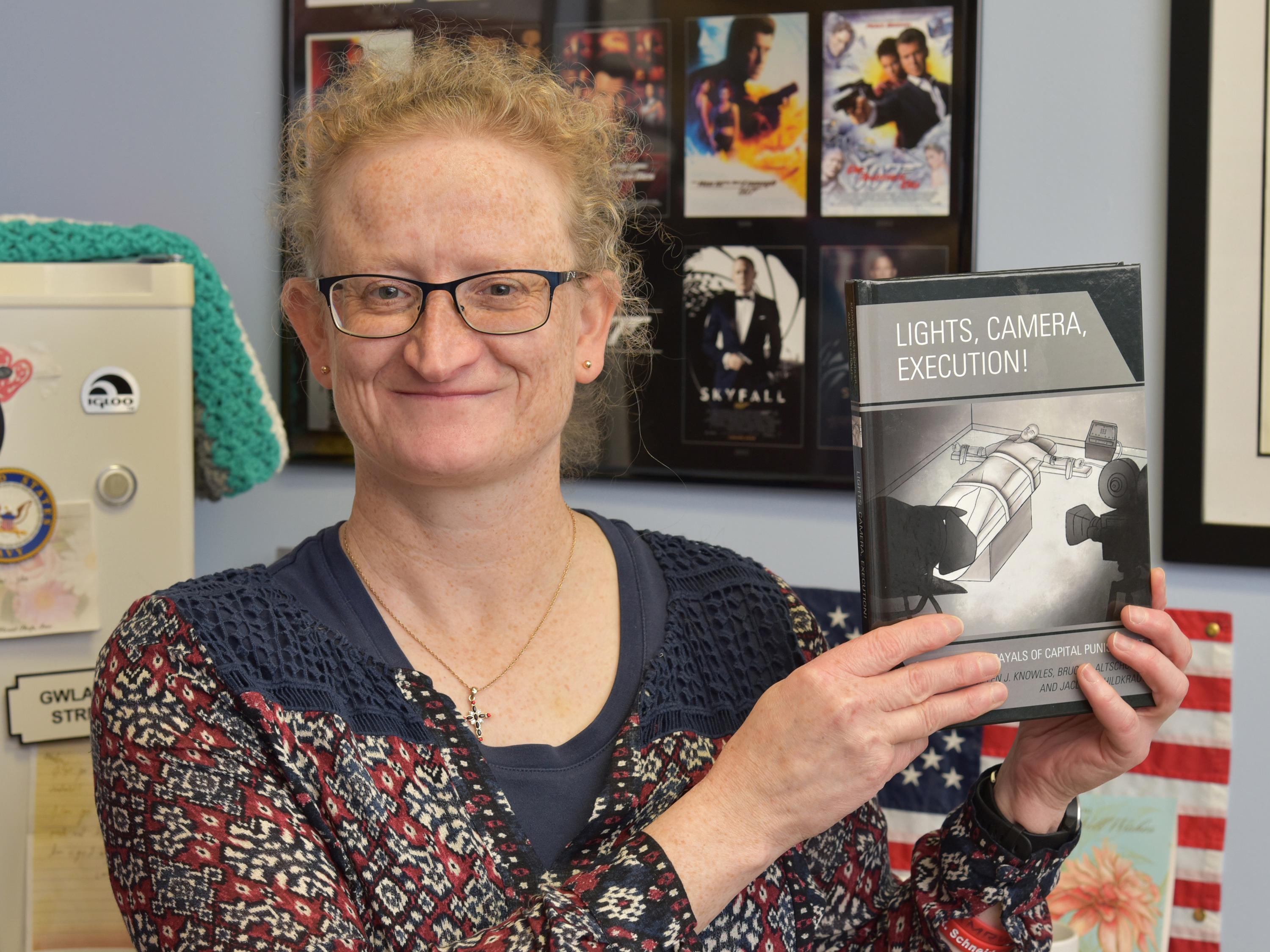Cinematic exploration -- Helen Knowles of SUNY Oswego’s political science faculty spearheaded the development of “Lights! Camera! Execution!: Cinematic Portrayals of Capital Punishment,” co-authored with Jaclyn Schildkraut of Oswego’s criminal justice faculty and political science emeritus professor Bruce Altschuler.
A collaboration between SUNY Oswego faculty members resulted in “Lights! Camera! Execution!: Cinematic Portrayals of Capital Punishment.”
Current faculty members Helen Knowles and Jaclyn Schildkraut, and political science emeritus professor Bruce Altschuler co-wrote the Lexington Books title, which came together surprisingly fast and with an unusual inspiration, Knowles said.
Knowles recalled her partner, John Gardner, “suggested we watch an obscure early ‘80s made-for-TV movie called ‘Murder in Coweta County.’” Based on a true story, the movie was about a wealthy, powerful landowner who killed one of his farmhands, but did so in the adjacent county that he did not control. In an interesting bit of casting, Andy Griffith — known for his role as beloved characters — played the murderer, while Johnny Cash played the crusading sheriff who brought him to justice.
“It’s about the rule of law and how it related to the death penalty,” said Knowles, an associate professor of political science. “After I watched this film, I thought this might be something very very good to teach. I did more research and found there was no book about the death penalty and the movies for use in the classroom.”
Conversations with her former colleague Altschuler, who has written frequently about stage and cinematic portrayals of political topics, and Schildkraut of the criminal justice faculty led to the three deciding to try to write a book on the topic.
“I quickly answered yes as it combined quite a few of my interests,” said Altschuler, whose other books include “Seeing Through the Screen: Interpreting American Political Film.”
“During my last few years at Oswego, I developed an interest in politics and film and taught several political science courses on this subject as well as the English department's ‘World Cinema’ class,” Altschuler said. “Working with Helen and Jackie was an exciting opportunity.”
That opportunity tied in with Schildkraut’s teaching and research interests as well.
“I teach a death penalty course in the criminal justice program and am always interested to see how students make sense of the punishment,” said Schildkraut, an associate professor of criminal justice. “I thought it would be interesting to see how many of the issues surrounding this form of punishment that I teach about were also being portrayed in film.”
Project execution
From the time they committed to the project to when they signed a contract with Lexington Books to produce it was only about a month, which is nearly unheard of in academic publishing, Knowles said.
“We divided up some of the chapters, and we were really conscious about choosing a mix of well-known films and more obscure films,” Knowles said. In addition, all of the chapters connect with other films. The opening and closing chapters they wrote as a group.
“We all had chapters we really wanted to do,” Knowles said, in her case “Murder in Coweta County” and “A Lesson Before Dying,” which her mother, teaching inmates at the time, learned about from a nun also working at the jail. Altschuler contributed “Thin Blue Line,” “Dead Man Walking” and “The Life of David Gale.” Schildkraut wrote on “The Green Mile,” “Monster’s Ball” and “Last Dance” -- the latter being a rare case of a capital punishment film about a woman, Schildkraut noted.
“One of the things I’m really proud about is how this is a SUNY Oswego collaboration through and through,” Knowles noted, as they worked with three students in Andre Nichols, Emily Tepfenhart and Nick Stubba in the spring semester to fine-tune the content.
Shanika Scarborough, who is pursuing her master’s in graphic design from Oswego, created the cover. “She did a stunning job,” Knowles said. “They always say you can’t judge a book by its cover, but we’re really proud of what Shanika did for our cover.”
Wide application
The book focuses on specific recurring themes such as dignity, the rule of law, and race and racial discrimination.
“We were also very conscious that these chapters would not just be talking about capital punishment but also about cinematic techniques,” Knowles said.
As a result, Knowles thinks the book can appeal to a variety of courses, not just political science and cinema and screen studies, but also criminal justice, African-American studies and related fields. They also wrote the book to have appeal to movie lovers in general.
“The book is written in a way that non-expert audiences will understand,” Altschuler said. “That should include those interested in film, legal issues (particularly the death penalty) or both. Beyond the issue of the death penalty, the book discusses how Hollywood approaches controversial legal and moral issues. We also believe that the book will be ideal for both undergraduate and graduate college courses when it comes out in a paperback edition.”
Schildkraut agreed that the book could find interest with “a broad range of audiences, from students and scholars of the death penalty to people in the general public who are interested in the topic,” she said. “I believe my co-authors and I did a good job of taking material that could be very heavy in terms of the legal and criminal justice processes connected to the issue and making it understandable and relatable for a broader group of readers.”




